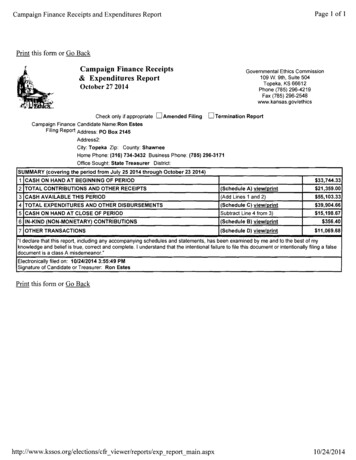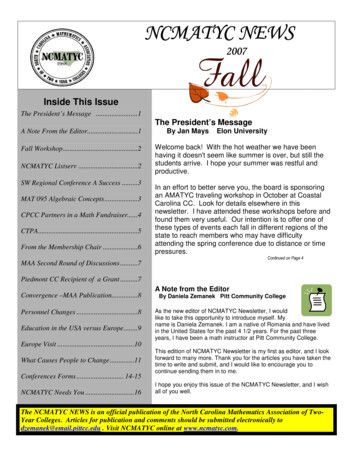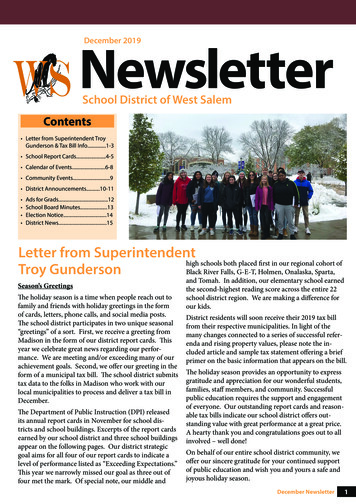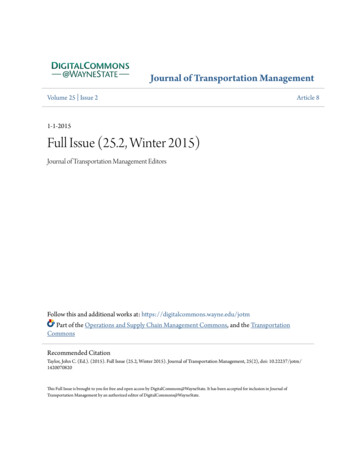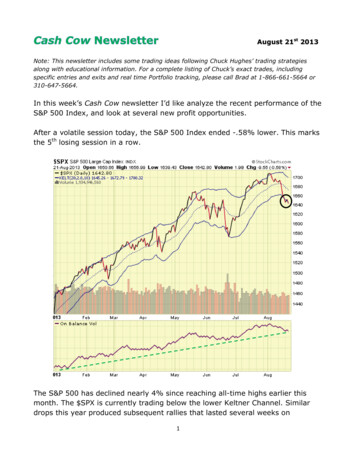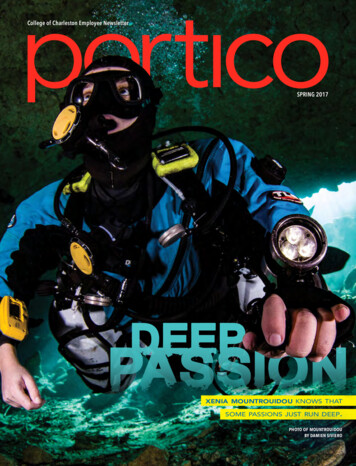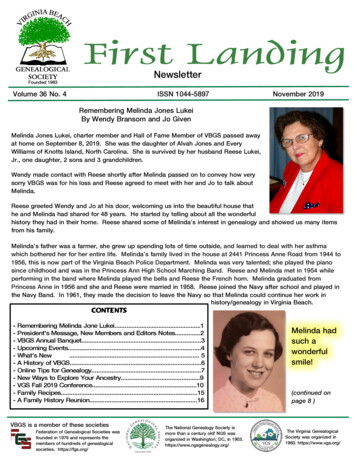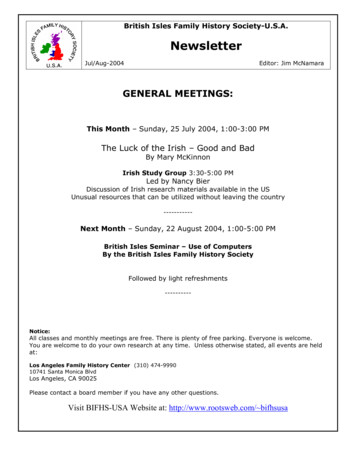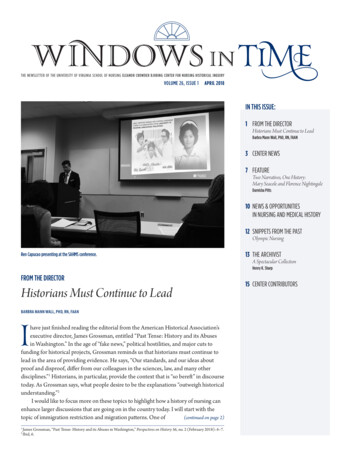
Transcription
THE NEWSLETTER OF THE UNIVERSITY OF VIRGINIA SCHOOL OF NURSING ELEANOR CROWDER BJORING CENTER FOR NURSING HISTORICAL INQUIRYVOLUME 26, ISSUE 1APRIL 2018IN THIS ISSUE:1 FROM THE DIRECTORHistorians Must Continue to LeadBarbra Mann Wall, PhD, RN, FAAN3 CENTER NEWS7 FEATURETwo Narratives, One History:Mary Seacole and Florence NightingaleDarnisha Pitts10 NEWS & OPPORTUNITIESIN NURSING AND MEDICAL HISTORY12 SNIPPETS FROM THE PASTOlympic NursingRen Capucao presenting at the SAHMS conference.13 THE ARCHIVISTA Spectacular CollectionHenry K. SharpFROM THE DIRECTORHistorians Must Continue to LeadIBARBRA MANN WALL, PHD, RN, FAANhave just finished reading the editorial from the American Historical Association’sexecutive director, James Grossman, entitled “Past Tense: History and its Abusesin Washington.” In the age of “fake news,” political hostilities, and major cuts tofunding for historical projects, Grossman reminds us that historians must continue tolead in the area of providing evidence. He says, “Our standards, and our ideas aboutproof and disproof, differ from our colleagues in the sciences, law, and many otherdisciplines.”1 Historians, in particular, provide the context that is “so bereft” in discoursetoday. As Grossman says, what people desire to be the explanations “outweigh historicalunderstanding.”2I would like to focus more on these topics to highlight how a history of nursing canenhance larger discussions that are going on in the country today. I will start with thetopic of immigration restriction and migration patterns. One of(continued on page 2)12James Grossman, “Past Tense: History and its Abuses in Washington,” Perspectives on History 56, no. 2 (February 2018): 6–7.Ibid, 6.15 CENTER CONTRIBUTORS
Eleanor Crowder BjoringCenter for Nursing Historical InquiryStaffBarbra Mann Wall, PhD, RN, FAAN, Directorbmw8y@virginia.eduMary E. Gibson, PhD, RN, Associate Directormeg2e@virginia.eduJohn C. Kirchgessner, PhD, RN, PNP, Assistant Directorjkirchgessner@sjfc.eduBarbara Brodie, PhD, RN, FAAN, Director Emeritabb9w@virginia.eduArlene Keeling, PhD, RN, FAAN, Director Emeritaawk2z@virginia.eduLinda Hanson, MSM, Project Coordinatorllh3x@virginia.eduCenter AssociatesW. Bernard Carlson, PhDwc4p@virginia.eduAnne Z. Cockerham, PhD, RN, CNM, WHNPAnne.Cockerham@frontierschool.eduRebecca Coffin, PhD, RNrc4da@virginia.eduSarah J. Craig, PhD, RN, CCNS, CCRNsjw5y@virginia.eduDeborah L. Gleason, PhD, APRN, CPNPdlg7b@virginia.eduMichelle Hehman, PhD, RNmch2at@virginia.eduBridget Houlahan, PhD, RNbah3jb@virginia.eduJessica Malpass, PhD, RNjlk2t@virginia.eduGwyneth Milbrath, PhD, RN, MPHgwyneth@uic.eduNena Powell, PhD, RNpowellnj@jmu.eduLisa Zerull PhD, RN, FCNlzerull@valleyhealthlink.comCenter AffiliatePamela B. DeGuzman, PhD, MBA, RNdeguzman@virginia.eduWindows in TimeJohn C. Kirchgessner, EditorLinda Hanson, Assistant EditorRoseberries, DesignBrodie Fellows(From the Director, continued from page 1)our students, Reynaldo Capucao, is studying the huge Filipino migration of nurses inthe 1970s that helped alleviate the US nursing shortage. The history of these nursesincludes studying migration of families and the search for economic opportunity.Yet he reminds us that their history also must be discussed within past contexts suchas the National Origins Act of 1924, the 1946 War Brides Act, the 1947 passage ofthe Military Bases Agreement between the U.S. and the Philippines, and the 1965Immigration Act.Another student, Victoria Tucker, is studying the history of African Americannurses in Virginia during the age of desegregation. This is not only a history aboutnursing but also about race. Ms. Tucker’s work uses African American nurses inVirginia as a lens to understand how issues of race and racism affected the development of American nursing and the health care profession as a whole. Virginiahistorically was a bastion of resistance to integration, and Ms. Tucker reminds usthat African American nurses lived and worked in an area marked by segregation thatdates back to the beginning of the colony in the 1600s. Indeed, slavery, segregationistpractices, access to education, gender, state policies, and Supreme Court decisions of1896 and 1954 all require consideration.In addition to research, the Eleanor Crowder Bjoring Center for NursingHistorical Inquiry maintains its commitment to diversity and inclusion through newprojects. We are adding to our “Hidden Nurses” collection with a special interest innurses from the South. To this end, Dr. Phoebe Pollitt provided us documents onCherokee nurses in North Carolina. We are collecting documents from nurses inthe Ozark Mountains of Missouri, voices who have not been heard before. And wecontinue to seek more, with the understanding that great trust must be establishedbefore some nurses will give up their documents. Gaining this trust is our first step.Finally, our guest author for this issue of Windows in Time is Darnisha Pitts. Asan undergraduate student at the University of Virginia School of Nursing, she wrotea paper on Mary Seacole. We feature this paper today as an important “hidden nurse”who has only recently re-appeared in nursing history.Returning to Grossman’s comments, “The role of history and historians in publiclife has never before been more visible or less clear.”3 As we work with students andothers in nursing history, we will continue to discuss the nature of historical evidence,context, who becomes subjects of nursing history, and why each is important. n32018–2020 Michelle Hehman, PhD, RN2017–2019 Tommy Dickinson, PhD, RNIbid, 7.Center VolunteersCarolyn J. DuValRobert DuValWindows in Time can be found on EBSCOhost andGale Group, Inc. databases.Windows in Time (Print) ISSN 2576-5213Windows in Time (Online) ISSN 2576-5221Contact InformationCenter Phone (434) 924-0083Center emaiCenter website nursing.virginia.edu/cnhi 2018 by the Rector and Visitors of the University of Virginiafacebook.com/uvanursing 2WINDOWS IN TIMEThe Eleanor Crowder Bjoring Center for Nursing Historical Inquiry(ECBCNHI), established at the University of Virginia in 1991 to supporthistorical scholarship in nursing, is dedicated to the preservation and study ofnursing history. The development of advanced clinical nursing practice, andthe clinical specialty organizations that represent the various practices, is amajor focus of the Center. The goals of the Center include the collection of materials, the promotion ofscholarship, and the dissemination of historical research findings.twitter.com/uvasonUNIVERSITY OF VIRGINIA SCHOOL OF NURSINGwww.nursing.virginia.edu/cnhi
Nursing the Navajo, 1920–1950:Nurses of the Bureau of Indian Affairs(later called the Indian Health Service)Affairs delivered a supply of wood andcoal, just in time for the cold winterahead. During the month of December,Forster treated 138 Navajo patients,recruiting them to the clinic with thepromise of hot soup and a warm fire.The nurses held “nursing conferences” to instruct the Navajo womenabout infant and child care, sanitation,nutrition, and the importance of prenatalcare. The nurses also conducted wellbaby check-ups, examined sick infantsand children, and made home visits. InMay 1935, Nena Seymour made homevisits to 76 different hogans, treating sorethroats, ear infections, cuts, impetigo andother commonly occurring illnesses.The window commemorates thepublic health nurses who served amongthe Navaho. nPHOTO BY COE SWEETIMary GibsonAssociate DirectorNamedWPHOTO BY JENNIFER BYRNEn the 1920s, three trained Red Crossnurses were assigned to field workon the Navajo Reservation—anopen desert, inhabited by the nomadic,sheep-herding Navajo. The nurses’ workin the Four Corners’ Region was anexperimental public health program—part of a federal government initiativeto provide health care to AmericanIndians on reservations throughout theUnited States. By 1931, experiencedpublic health nurse Elizabeth Forster wasstationed at Red Rock, about 20 milesaway from Ship Rock—on the border ofNew Mexico and Arizona. She opened aclinic there in an abandoned mission.In December 1931, Public HealthNurse Elizabeth Forster lived in twotiny rooms, treating patients in her tinykitchen. That month the Bureau of IndianWINDOWS IN TIMEe are pleased toannounce thatDr. Dorrie Fontainehas appointed Mary E. Gibson,PhD, RN as Associate Directorof the Eleanor Crowder BjoringCenter for Nursing HistoricalInquiry. Dr. Gibson has servedas Assistant Director for the pastseveral years. She has her PhD fromthe University of Pennsylvania andstudies the history of health care forchildren. She is currently Presidentof the American Association forthe History of Nursing and in thepast served as President of the BetaKappa Chapter of Sigma ThetaTau, International. Please join us inwelcoming her in this new role. nELEANOR CROWDER BJORING CENTER FOR NURSING HISTORICAL INQUIRYAPRIL 20183
CENTER NEWSPresentations, Publications & AwardsFACULTYCraig, S. & Cieslowski, B. “WhenMannequins Didn’t Talk Back: TheHistory of Simulation and Debriefing inNursing Training.” Paper presented atthe Southern Association for the Historyof Medicine and Science Conference,February 16, 2018, Augusta, GA.Seidl, K. & Gibson, M.E. “Midwiferyin New Zealand: Shifts in Power andResponsibility Since 1990.” Paperpresented at the American Associationfor the History of Nursing Conference,Fairport, New York, September 8, 2017.Gibson, M.E. Book Review: DiscoveringTuberculosis: A Global History 1900 to thePresent, by Christian McMillan, NursingHistory Review, 26 (2018), 230–232.Gibson, M.E. (2017) “HistoricalPerspectives on the Use of Technologyin Maternal and Newborn Care, GuestEditorial.” Journal of Obstetric, Gynecologic,& Neonatal Nursing, 46 (2017), 617–618.Gibson, M.E. “An Early History ofAnesthesia in Labor.” Journal of Obstetric,Gynecologic, & Neonatal Nursing,46 (2017), 619–627. , M.E. “The Price of Free Labor:Nursing Education at the University ofVirginia Hospital, 1901–1968.” Paperpresented at the Southern Associationfor the History of Medicine andScience Conference, February 16, 2018,Augusta, GA.Houlahan, B. “From New York Cityto Richmond, Virginia”: The Spreadof School Nursing at the Turn of theTwentieth Century. Paper presented atthe American Association for the Historyof Nursing Conference, September 9,2017, Fairport, NY.Houlahan, B. “Origins of SchoolNursing.” Journal of School Nursing.Article first published online:October 11, 2017 https://doi.org/10.1177/1059840517735874Milbrath, G. “Burns En Masse:Naval Hospital Pearl Harbor, 1941.”September 8–9, 2017. Paper presented atthe American Association for the Historyof Nursing Conference, Fairport, NY,September 8, 2017.Milbrath, G., and Sacco, T. “Pearl HarborBurn Care, December 1941: Connectingthe Past to Current Practice.” Posterpresentation at the American BurnAssociation Annual Meeting: Chicago, IL,April 12, 2018.Maldonado, L.T. and Wall, B.M. (2017).Chapter 11: “Health care as women’srights: the Maternity Care Coalition— thePhiladelphia story.” In Nursing Historyfor Contemporary Role Development,edited by S. Lewenson, A. McAllister, andK. Smith. New York: Springer PublishingCompany, 2016.Wall, B.M., Lewenson, S., Connolly, C.“The Uses and Abuses of Historical‘Lenses’.” Panel presentation at theAmerican Association for the History ofNursing Conference, September 8, 2017,Fairport, NY.AAHN 2017 conference participants.Wall, B.M. & Apple, R.D. “Trends inPublishing Nursing History: Sourcesand Strategies to Enhance ScholarlyProductivity.” Preconference workshop atthe American Association for the History ofNursing, Fairport, NY, September 7, 2017.Wall, B.M. & Keeling, A. (2017).Historical highlights in disaster nursing.In J. Truglio-Londrigan & S. Lewenson(Eds.), Public health nursing: Practicingpopulation-based care (pp. 377–391).Boston: Jones and Bartlett Publishers. 4WINDOWS IN TIMEUNIVERSITY OF VIRGINIA SCHOOL OF NURSINGwww.nursing.virginia.edu/cnhi
CENTER NEWSSchroeder, N. “‘Incurable Defects’:Physical Disability and the PhiladelphiaOutpatient Relief System, 1790–1840.”Paper presented at the SouthernAssociation for the History of Medicineand Science Conference, February 17,2018, Augusta, GA.Seidl, K. & Gibson, M.E. “Midwiferyin New Zealand: Shifts in Power andResponsibility Since 1990.” Paperpresented at the American Associationfor the History of Nursing Conference,Fairport, New York, September 8, 2017.SAHMS 2018 conference participants.STUDENTCapucao, R. “A Culture to Care: TheHistory of Filipino Nurses in HamptonRoads, 1947–1992.” Paper presented atthe Southern Association for the Historyof Medicine and Science Conference,February 17, 2018, Augusta, GA.Carhuapoma, L.R. “Matriarchs of theOperating Room: Nurses, Neurosurgery,and Johns Hopkins Hospital, 1920–1940.”Podium presentation at the SouthernAssociation for the History of Medicineand Science Conference, February 17,2018, Augusta, GA.Carhuapoma, L.R. “Nursing Influencein the Development of NeurocriticalCare: The Johns Hopkins Hospital,1920–1950.” Paper presented at theIAmerican Association for the History ofNursing Conference, Fairport, New York,September 8, 2017.Hundt, B. “St. Elizabeth’s Hospital:The Kirkbride Plan to the Cottage Plan,1852–1899.” Paper presented at theSouthern Association for the Historyof Medicine and Science Conference,February 17, 2018, Augusta, GA.Kumodzi, T. “The Death Lab of CharmCity: A Historical Perspective of theSignificance of Place to Trauma NursingInnovation.” Paper presented at theSouthern Association for the Historyof Medicine and Science Conference,February 17, 2018, Augusta, GA.t is with great sadness that we announce the passingof Sadie Marian Smalls of New York, New York.Dr. Smalls received her Bachelor of Science in Nursingdegree from A and T College (now University). Shecompleted further study at Teacher’s College–ColumbiaUniversity, in New York City, where she earned a Masterof Arts Degree, Master of Education Degree, and PhD inWINDOWS IN TIMETucker, V.N. “‘Endurance from a wayback time’: Experiences of Black nurses inVirginia, 1950s–1980s.” Paper presentedat the American Association for theHistory of Nursing Conference, Fairport,New York, September 8, 2017.Tucker, V.N. “Moving Lines: A HistoricalAnalysis on the Experiences of BlackNurses in Virginia and the Meaning ofPlace, 1950s–1980s.” Paper presented atthe Southern Association for the Historyof Medicine and Science Conference,February 17, 2018, Augusta, GA.Bridget Houlahan, PhD, RN accepteda tenure-track pediatric position at JamesMadison University. nEducation. Her work as a nurse spanned nearly fifty years,and she published numerous articles and pamphlets nursingand health. She was a great supporter of nursing history, andalways provided compelling and interesting comments atour annual American Association for the History of Nursingmeetings. We will miss her greatly, and her legacy to nursingand to nursing history will be lasting. nELEANOR CROWDER BJORING CENTER FOR NURSING HISTORICAL INQUIRYAPRIL 20185
CENTER NEWSCongratulations to Our New PhDs!On December 12, 2017, Elizabeth Hundt successfullynineteenth century came to a close, the overcrowding impacteddefended her dissertation, A Noble Monumentthe landscape of the hospital and the care provided to thoseof Wisdom and Mercy: St. Elizabeths Hospital,suffering from mental illness. Despite the move away from1852–1899. Dr. Hundt’s research studiedtreatment that was based on nature, theSt. Elizabeths Hospital in Washingtonhospital’s history provides a foundationD.C., an asylum to treat the soldiers,for critical examination of the therapeuticsailors, and indigent citizens of theenvironment of hospitals today.District, and designed to be a modelinstitution. When it opened in 1855,On March 29, 2018, Franklin Hickeythe hospital represented hope for a curesuccessfully defended his dissertation,for insanity by promising treatment that“Doing Something”: Oral and Writtenwas built on the idea that a preciselyNarratives of Nurses’ Experiences of thecontrolled, therapeutic environmentSeptember 11, 2001 Disaster. Dr. Hickey’scould calm the mind. The hospital wasdissertation identified, described, andbuilt using the Kirkbride Plan for asylumanalyzed the responses of local nursesdesign and management. Architecturefrom New York and New Jersey andand nature were essential elements to theWe are very proud of our new PhDs, Franklin Hickey andthe challenges faced by the healthcareBeth Hundt!ordered environment of the asylum andteam the first few days following thethe treatment provided to patients.September 11, 2011, disaster at theThe purpose of this research was to identify, describe,World Trade Center in New York City.and analyze the history and design of nineteenth century St.He illustrated how nurses in select hospitals and clinics inElizabeths Hospital, particularly related to the use of nature andNew York and New Jersey acted after the disaster and what thosethe built environment in the treatment of mental illness. Theexperiences meant to them. Nurses faced situations they had nothospital was indeed a crossroads of ideas and actions of the leadersimagined and for which they had not prepared. In order to makeof the time, including reformers, politicians, physicians, architects,sense of these terrible events, nurses constructed cohesive storieslandscape gardeners, and nurses; the focus being the interactionin which they, at first, felt vulnerability, fear, and anger. Narrativesbetween the patient and the environment for health and well-being.eventually were replaced with broader ones of nurses with a senseHowever, the overcrowding at St. Elizabeths followingof purpose, who used their education and technical skills to “dothe American Civil War proved that a cure was elusive. As thesomething” in order to help others. nBarbara Brodie Nursing History FellowshipThe Eleanor Crowder Bjoring Center for NursingHistorical Inquiry Barbara Brodie Nursing HistoryFellowship, a postdoctoral award, is open to nursesengaged in historical scholarship that advances the field ofnursing history. Applications for the 3000 award are dueOctober 15, 2018, and the recipient will be announcedin December, 2018. The selected Barbara Brodie NursingHistory Fellow will present a paper from their research inthe Center’s Nursing History Forum series. 6WINDOWS IN TIMESelection of the fellow will be based on the scholarlyquality of the investigator’s project including: the clarity ofthe project’s purpose, its rationale and significance, the rigorof its methodology and questions posed, and its potentialcontributions to the field of nursing.The application and a curriculum vitae should be sentby email to the Center’s Director, Dr. Barbra Mann Wall,bmw8y@virginia.edu. Applications are available on the Center’swebsite: UNIVERSITY OF VIRGINIA SCHOOL OF NURSINGwww.nursing.virginia.edu/cnhi
Two Narratives,One HistoryMary Seacole and Florence NightingaleDARNISHA PITTSNursing Student, University of Virginia School of NursingWINDOWS IN TIMEINCHESTERCOLLEGE/INAIDOF MARY SEACOUE APLE MEMORIAL STATPE ASANEVRYAL/ MIn the early 19th century nurses hadthe reputation of being poor, coarse, andignorant. Nightingale’s work in theCrimea as well as the media of the timehelped change this image of nurses.1Nightingale will forever be knownas the “Lady with the Lamp,” animage popularized in illustrations ofher with injured soldiers in Scutariduring the Crimean War. In 1857Henry Wadsworth Longfellow alsoimmortalized Nightingale in hispoem, Santa Filomena.Following the Crimean War,Nightingale used her experiencesin Scutari to propose hospitalreform in Britain, established aschool for formal nursing education,FOand established fundamental sanitaryYESTURCOprinciplesfor environmental hygiene. TheseTIAPORTRaccomplishments and her angelic media imagefurther contributed to a new image for the nursingWONE RARELY FINDS A nursingstudent today who has notheard about FlorenceNightingale, or “The Lady with theLamp.” Nightingale has long beenthe iconic face of nursing. Hershining example, however, hasunintentionally overshadowedother famous nurses from hertime, in particular, the “hiddenfigure” Mary Seacole. Anexamination of both women’sbackground and contributionsduring the Crimean War providesa window on how nineteenthcentury views of class and racecontributed to Nightingale’s iconicstatus and the devaluing of many otherswho, like Seacole, provided skilled nursingcare. While there is continued debate onwho should truly be recognized as nurses, itis important to examine how this one-sided historymight be detrimental to theMary Jane Seacole (1805–1881), Jamaicanimage of nursing particularlyborn British Crimean War nurse. She wasalso known as Mother Seacole.for people of color.1Bernard Cohen, “Florence Nightingale,” Scientific American, 250, no.3(1984):128. Accessed February 12, 2017. ngale.pdfELEANOR CROWDER BJORING CENTER FOR NURSING HISTORICAL INQUIRYAPRIL 20187
Two Narratives, One History: Mary Seacole and Florence Nightingaleprofession and nurses—primarily white women from familiesaid because my blood flowed beneath a somewhat duskierof respected classes.skin than theirs?”7 Despite these rebuffs, Seacole traveled toCleaning and providing nourishment were thethe British base at Balaclava with medical supplies, wherefundamental tasks in the care of soldiers in the Crimea, andshe created the “British Hotel.” Among her nursing dutiesNightingale and her nurses clearlywas providing nutrition,contributed to the overall improvementincluding delicacies suchof patient care. Other women, however,Cleaning and providing nourishmentas lemonade and spongeincluding black women, also worked ascake, for the wounded andnurses and used the very same skills towere the fundamental tasks inill soldiers.care for those who were injured, ill, andIn her autobiography,dying. One of these women was Marythe care of soldiers in the Crimea,Seacole described herSeacole, a Jamaican born Creole.2positions as doctress, nurse,Seacole was born and raised inand Nightingale and her nursesand “mother.”8 Over time,Kingston, Jamaica. Her father was ashe started having moresoldier from a Scottish family, andclearly contributed to the overallpatients of her own at theher mother was a Creole woman whoBritish Hotel where neededpracticed “doctoring” at a boardingimprovement of patient care. Othernourishment, comforthouse. In her autobiography, Seacolefood, and remedies weredescribed a particular trip to Londonwomen, however, including blackprovided. Some of theseat the age of eighteen: “strangelyremedies only Seacole couldenough, some of the most vivid ofwomen, also worked as nurses andprovide and doctors couldmy recollections are the efforts of thenot.9 Her role as comforterLondon street-boys to poke fun at meused the very same skills to care forand caretaker became welland my companion’s complexion. I amknown by those in need asonly a little brown —a few shades duskierthose who were injured, ill, and dying.she worked to provide athan the brunettes whom you all admire“home.” Her care and dediso much.”3 She took pride in her Scottishcation are reflected in theroots, but she was also aware of how others viewed her as akind words found in a testimony from the Adjutant-General’s“lazy Creole” and protested such claims stating, “I am sure I dooffice of the British Army:4not know what it is to be indolent.”“Mrs. Seacole was with the British army in the CrimeaDriven to achieve her life goal to be a healer, Seacolefrom February, 1855, to this time. This excellent woman hasapprenticed with her mother in the art of home remediesfrequently exerted herself in the most praiseworthy manner inbased on African herbs. Like her mother, she became a skilledattending wounded men, even in positions of great danger, andhealer and enhanced her reputation while caring for the sickin assisting sick soldiers by all means in her power. In addition,during a yellow fever epidemic in 1853.5 When the Crimeanshe kept a very good store, and supplied us with many comWar broke out, Seacole was in London on a business trip andforts at a time we much required them.”10she heard that Nightingale had left England for the CrimeaA newspaper correspondent, also noting her brave efforts,6with a group of nurses. She, too, wanted to do her share inwrote, “I have seen her go down, under fire, with her little storeaiding the wounded, applied to the Secretary-at-War to be aof creature comforts for our wounded men; and a more tendernurse, was interviewed by one of Nightingale’s companions,or skillful hand about a wound or broken limb could not beand was turned down by both. Devastated at her rejection,found among our best surgeons.”11 Despite these accolades,she questioned, “Did these ladies shrink from accepting mySeacole also recalled being “under fire” as she became thecenter of attention as a woman of color. Still, she found a way2Mary Elizabeth Carnegie, The Path We Tread: Blacks in Nursing Worldwide, 1854–1994.to contribute and make a difference through hard work and(Sudbury, MA: Jones and Bartlett, 2000), 4.Mary Seacole, Wonderful Adventures of Mrs. Seacole in Many Lands. (London: JamesBlackwood Paternoster Row, 1857), 4.4Ibid., 2.5D.P. Griffon, “‘A Somewhat Duskier Skin’: Mary Seacole in the Crimea.” Nursing HistoryReview 6, (1998): 117.6Seacole, Wonderful Adventures of Mrs. Seacole in Many Lands, 78.3 8WINDOWS IN TIMEIbid., 79Ibid., 124.9Ibid., 125.10Ibid., 132.11Ibid., 17178UNIVERSITY OF VIRGINIA SCHOOL OF NURSINGwww.nursing.virginia.edu/cnhi
Two Narratives, One History: Mary Seacole and Florence Nightingaledetermination. She was not funded by the government likeBoth Nightingale and Seacole broke new ground in theirNightingale but instead paid her own fare to be where sheera, and both should receive recognition for their differentcould assist in the way that she knew how.12 When the warcontributions to nursing. In some ways, they are similar.ended, Seacole was financially bankrupt. Although she did notBoth were females in a patriarchal British society, and bothcontinue as a nurse or write books on nursing, hospitals, andwere determined to implement their approaches to nursinghealth reform, her work in Crimea was meaningful to her andand patient care. Nightingale worked from an administrativeto those whose lives were improved by her determination, skill,viewpoint to improve patient care, while Seacole focusedand selfless care.her energies on being at the bedside of the wounded andOver the years, there have been many debates on whetherill and providing comfort measures to ease the suffering ofor not Seacole deserves recognition. Lynn McDonald’sher patients.influential work on Nightingale notes that Seacole wasIt is hard to dispute that Seacole was a leader in caringrecognized as a pioneer nurse in some circles, but shefor those in need during the Crimean War just as Nightingalequestions this title because she found scant documentationwas. However, Seacole’s race and class have likely contributed13of Seacole’s heroic contributions. Although McDonald doesto her contributions being overshadowed in past histories ofsuggest that Seacole deserves muchthe Crimean War. Each ofcredit for her care of the wounded andthese women came fromill, McDonald asserts that Seacole shouldIn the face of rejection fromdifferent race and classnot be recognized as a “pioneer nurse”backgrounds. Nightingale,or a hero of health care. McDonald alsoofficials, Seacole worked with greata Victorian woman,notes that Seacole never officially workedcame from a privilegedin a hospital. Yet the experience Seacoledetermination to practice her skillsbackground and defiedgained as a healer in Jamaica preparedconventional norms for aher to be a bedside nurse in Crimea andas a nurse and improve the lives ofnineteenth-century woman.contributed to the well-being of theShe came from the properill and wounded just as Nightingale’sthose who were in need during thelineage and had access toleadership role did.educational opportunities,Recent events have fueled the debateCrimean War.powerful people, and aover Seacole’s significance, includingpress that would enhancewhen Michael Gove, the Unitedher ability to make her16Kingdom’s Education Minister, stripped Seacole from thevoice heard. Nightingale became the nursing icon. Seacole,national curriculum, claiming she was just a “mere tool of theby contrast, was a Jamaican-Creole and Scottish woman who14multiculturalist agenda.” The Daily Mail referred to Seacoleconsidered herself “a little brown,” not “white.” She learned heras “the black Florence Nightingale,” a demeaning term thatnursing skills from her mother. As D. P. Griffon notes, Seacole15does not recognize her fully as an individual. Tensions arosebrought traditional healing skills to Crimea that went againstin 2016 when a statue was raised in Seacole’s honor outsidethe bleeding and purging of English medicine of the day.Nightingale’s London hospital. Nightingale devotees reacted inFurthermore, she was not English and was not from the middleangry retaliation at this perceived threat to Nightingale’s honor.and upper classes of society.17 In the face of rejection fromIt is interesting to think that they would view Seacole as such,officials, Seacole worked with great determination to practicegiven that she provided much-needed bedside nursing skillsher skills as a nurse and improve the lives of those who were inand acts of comfort, the same care provided by Nightingaleneed during the Crimean War. As Nightingale’s narrative hasand her nurses.become the received one for nurses, it is helpful to be familiarwith a second narrative, that of Seacole’s, a narrative very12Elizabeth Anionwu, What Can Florence and Mary Teach Us About Nursing Today? Videodifferent from Nightingale’s but every bit as much a part of theFile. (20
n the 1920s, three trained Red Cross nurses were assigned to field work on the Navajo Reservation—an open desert, inhabited by the nomadic, sheep-herding Navajo. The nurses’ work in the Four Corners’ Region was an experimental public health program— part of a federal government initi

